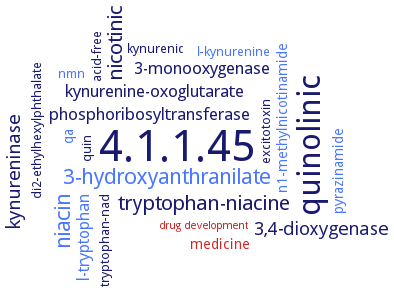4.1.1.45: aminocarboxymuconate-semialdehyde decarboxylase
This is an abbreviated version!
For detailed information about aminocarboxymuconate-semialdehyde decarboxylase, go to the full flat file.

Word Map on EC 4.1.1.45 
-
4.1.1.45
-
quinolinic
-
3-hydroxyanthranilate
-
niacin
-
tryptophan-niacine
-
nicotinic
-
kynureninase
-
3,4-dioxygenase
-
kynurenine-oxoglutarate
-
phosphoribosyltransferase
-
3-monooxygenase
-
l-tryptophan
-
pyrazinamide
-
n1-methylnicotinamide
-
medicine
-
qa
-
l-kynurenine
-
acid-free
-
kynurenic
-
di2-ethylhexylphthalate
-
quin
-
tryptophan-nad
-
excitotoxin
-
nmn
-
drug development
- 4.1.1.45
-
quinolinic
- 3-hydroxyanthranilate
- niacin
-
tryptophan-niacine
-
nicotinic
- kynureninase
-
3,4-dioxygenase
-
kynurenine-oxoglutarate
-
phosphoribosyltransferase
-
3-monooxygenase
- l-tryptophan
- pyrazinamide
- n1-methylnicotinamide
- medicine
- qa
- l-kynurenine
-
acid-free
-
kynurenic
-
di2-ethylhexylphthalate
-
quin
-
tryptophan-nad
-
excitotoxin
- nmn
- drug development
Reaction
Synonyms
2-amino 3-carboxymuconate 6-semialdehyde decarboxylase, 2-amino-3-carboxymuconate-6-semialdehyde decarboxylase, 3-(3-oxoprop-2-enyl)-2-aminobut-2-endioate carboxy-lyase, ACMS decarboxylase, ACMSD, ACMSD I, ACMSDase, alpha-amino beta-carboxymuconate epsilon-semialdehyde decarboxylase, alpha-Amino-beta-carboxymuconate-epsilon-semialdehade decarboxylase, alpha-Amino-beta-carboxymuconate-epsilon-semialdehyde beta-decarboxylase, alpha-amino-beta-carboxymuconate-epsilon-semialdehyde decarboxylase, alpha-amino-beta-carboxymuconic-epsilon-semialdehyde decarboxylase, Amino-carboxymuconate-semialdehyde decarboxylase, Decarboxylase, aminocarboxymuconate semialdehyde, hACMSD, NbaD enzyme, Picolinic acid carboxylase, Picolinic acid decarboxylase, picolinic carboxylase, Picolinic decarboxylase


 results (
results ( results (
results ( top
top





